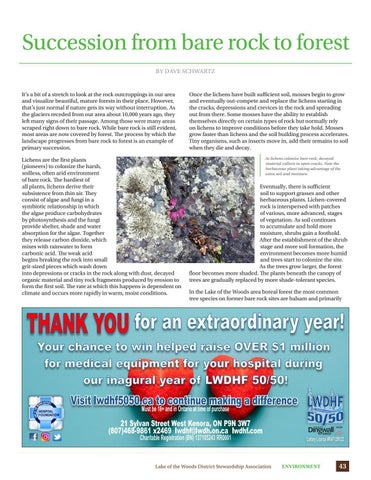Succession from bare rock to forest BY DAVE SCHWARTZ
It’s a bit of a stretch to look at the rock outcroppings in our area and visualize beautiful, mature forests in their place. However, that’s just normal if nature gets its way without interruption. As the glaciers receded from our area about 10,000 years ago, they left many signs of their passage. Among those were many areas scraped right down to bare rock. While bare rock is still evident, most areas are now covered by forest. The process by which the landscape progresses from bare rock to forest is an example of primary succession. Lichens are the first plants (pioneers) to colonize the harsh, soilless, often arid environment of bare rock. The hardiest of all plants, lichens derive their subsistence from thin air. They consist of algae and fungi in a symbiotic relationship in which the algae produce carbohydrates by photosynthesis and the fungi provide shelter, shade and water absorption for the algae. Together they release carbon dioxide, which mixes with rainwater to form carbonic acid. The weak acid begins breaking the rock into small grit-sized pieces which wash down into depressions or cracks in the rock along with dust, decayed organic material and tiny rock fragments produced by erosion to form the first soil. The rate at which this happens is dependent on climate and occurs more rapidly in warm, moist conditions.
Once the lichens have built sufficient soil, mosses begin to grow and eventually out-compete and replace the lichens starting in the cracks, depressions and crevices in the rock and spreading out from there. Some mosses have the ability to establish themselves directly on certain types of rock but normally rely on lichens to improve conditions before they take hold. Mosses grow faster than lichens and the soil building process accelerates. Tiny organisms, such as insects move in, add their remains to soil when they die and decay. As lichens colonize bare rock, decayed material collects in open cracks. Note the herbaceous plant taking advantage of the extra soil and moisture.
Eventually, there is sufficient soil to support grasses and other herbaceous plants. Lichen-covered rock is interspersed with patches of various, more advanced, stages of vegetation. As soil continues to accumulate and hold more moisture, shrubs gain a foothold. After the establishment of the shrub stage and more soil formation, the environment becomes more humid and trees start to colonize the site. As the trees grow larger, the forest floor becomes more shaded. The plants beneath the canopy of trees are gradually replaced by more shade-tolerant species. In the Lake of the Woods area boreal forest the most common tree species on former bare rock sites are balsam and primarily
Lake of the Woods District Stewardship Association Environment
43
























